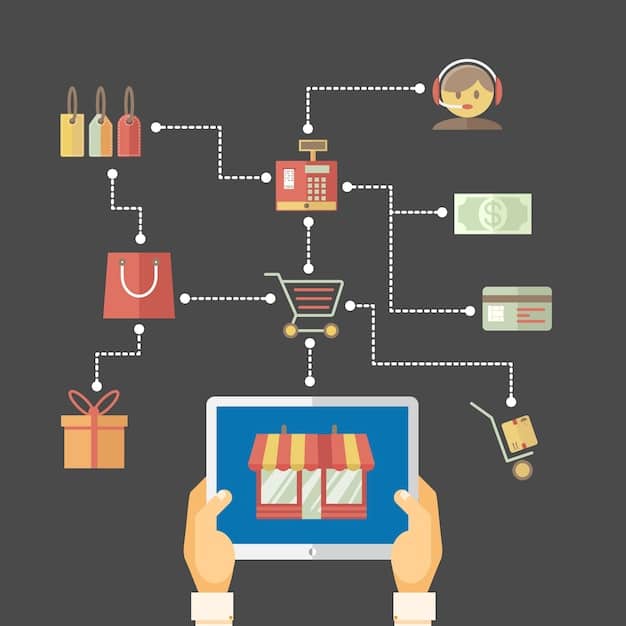E-commerce Platform Integration: Save Up to 20% on US Costs

E-commerce platform integration is crucial for US businesses aiming to streamline operations and reduce costs. A well-integrated system can save up to 20% by improving efficiency and reducing errors.
Are you looking to optimize your e-commerce operations in the US market? The key to unlocking significant cost savings and enhanced efficiency might just be in **e-commerce platform integration**. A seamless integration can transform your business, but how do you get started?
Many US businesses are already leveraging the power of integrated e-commerce systems to cut costs and improve customer experiences. Let’s explore how strategic **e-commerce platform integration** can help your company save up to 20% on operating costs.
Understanding E-commerce Platform Integration
E-commerce platform integration refers to the process of connecting various software systems that support your online business operations. This integration allows for a seamless flow of information between different platforms, reducing manual data entry and improving overall efficiency. The goal is to create a cohesive ecosystem where all your business functions work together harmoniously. This is where the value of **e-commerce platform integration** becomes clear.
Why is Integration Important?
Integrating your e-commerce platform with other business systems can have a significant impact on your bottom line. For many businesses operating in the US, integration is a must-have to stay competitive. Without it, you risk inefficiencies, errors, and missed opportunities. The benefits of efficient **e-commerce platform integration** are hard to ignore.
- Data Accuracy: Reduces manual data entry errors, ensuring accurate information across all systems.
- Increased Efficiency: Automates processes, freeing up staff to focus on more strategic tasks.
- Improved Customer Experience: Provides a more seamless and personalized shopping experience for customers.
- Better Decision Making: Offers real-time insights into your business performance, helping you make informed decisions.
Ultimately, understanding the importance of e-commerce integration paves the way for businesses to operate more effectively, serve their customers better, and achieve sustainable growth in the competitive US market. Effective **e-commerce platform integration** leads to more agile and responsive business operations.

How E-commerce Platform Integration Streamlines US Operations
For US businesses, optimizing operational efficiency is crucial for staying competitive. E-commerce platform integration plays a pivotal role in achieving this, by streamlining various processes across different business functions. By connecting your e-commerce platform with other systems, you can automate tasks, reduce errors, and improve overall productivity. Many businesses want to learn about **e-commerce platform integration** for better workflows.
Inventory Management
One of the most significant benefits of e-commerce integration is improved inventory management. When your e-commerce platform is integrated with your inventory management system, you can track stock levels in real-time, automate reordering processes, and prevent stockouts. The right approach to **e-commerce platform integration** can have a huge impact on your business.
Customer Relationship Management (CRM)
Integrating your e-commerce platform with your CRM system allows you to gather valuable customer data, personalize marketing efforts, and improve customer service. By having a 360-degree view of your customers, you can create targeted campaigns, offer personalized recommendations, and resolve issues more effectively.
Streamlining operations through integration not only boosts efficiency but also enhances customer satisfaction, leading to increased sales and long-term loyalty. This approach to **e-commerce platform integration** can significantly boost long-term growth in sales. US businesses can see a positive impact on their bottom line by taking these steps.
Cost Savings: Up to 20% Through E-commerce Platform Integration
One of the most compelling reasons for US businesses to invest in e-commerce platform integration is the potential for significant cost savings. By streamlining operations, automating processes, and reducing errors, businesses can cut costs across various areas of their operations. It is important to quantify the **e-commerce platform integration** savings.
Reduced Labor Costs
Automation reduces the need for manual data entry and other repetitive tasks, freeing up staff to focus on more strategic activities. This can lead to a reduction in labor costs, as you can achieve more with the same number of employees. This helps to show why **e-commerce platform integration** matters for growth.
Decreased Operational Costs
Improved inventory management, reduced shipping errors, and optimized marketing campaigns can all contribute to lower operational costs. By eliminating inefficiencies and waste, you can save money on everything from warehousing to customer support. You can achieve up to 20% in savings on operational costs through **e-commerce platform integration**.
- Lower Inventory Holding Costs: Efficient inventory management reduces the risk of overstocking, minimizing holding costs.
- Optimized Shipping: Integration with shipping providers allows for better tracking and cost-effective shipping options.
- Efficient Marketing Spend: Targeted marketing campaigns based on customer data ensure a higher return on investment.
Ultimately, the cost savings achieved through e-commerce platform integration can have a significant impact on your bottom line, allowing you to reinvest in other areas of your business and drive growth. Smart investments like **e-commerce platform integration** will always pay dividends.

Choosing the Right E-commerce Integration Solution
Selecting the right e-commerce integration solution is vital for maximizing the benefits of your investment. With numerous options available, it’s essential to carefully evaluate your business needs and choose a solution that aligns with your goals. Many businesses ask about the right method for selecting the right **e-commerce platform integration**. Here’s how to find the best option.
Assess Your Business Needs
Start by identifying the specific challenges you want to address and the processes you want to streamline. Consider your current systems, your future growth plans, and your budget constraints. A clear understanding of your needs will help you narrow down your options. When thinking about **e-commerce platform integration**, defining needs is the best way to start.
Evaluate Integration Options
Research different integration solutions and compare their features, pricing, and compatibility with your existing systems. Look for solutions that offer scalability, flexibility, and robust security features. Read reviews and ask for recommendations from other businesses in your industry.
- Custom Integration: Tailored solutions designed to meet your unique business requirements.
- Third-Party Integrations: Pre-built integrations offered by software vendors or integration platforms.
- API Integration: Connecting systems directly through their application programming interfaces (APIs).
Choosing the right e-commerce integration solution requires careful planning and research, but the investment will pay off in the form of improved efficiency, reduced costs, and enhanced customer experiences. Choosing the best option for **e-commerce platform integration** can lead to long-term benefits.
Best Practices for Successful E-commerce Platform Integration in the US
Implementing e-commerce platform integration effectively requires careful planning, execution, and ongoing maintenance. By following best practices, US businesses can ensure a smooth and successful integration process. Before launching **e-commerce platform integration**, here’s how to proceed.
Plan Thoroughly
Develop a detailed integration plan that outlines your goals, timelines, and budget. Identify key stakeholders and assign responsibilities. Conduct a thorough assessment of your existing systems and data to ensure compatibility. Plan for change management and employee training.
Test Extensively
Before launching your integration, conduct extensive testing to identify and resolve any issues. Test all aspects of the integrated system, including data flow, functionality, and security. Involve key users in the testing process to get their feedback and ensure that the integration meets their needs. Don’t underestimate the value of proper testing when doing **e-commerce platform integration**.
- Data Migration: Ensuring a smooth and accurate transfer of data from one system to another.
- Security Measures: Protecting sensitive data from unauthorized access and cyber threats.
- Monitoring and Maintenance: Continuously monitoring the integrated system to identify and address any issues.
By following these best practices, US businesses can maximize the benefits of e-commerce platform integration and achieve their desired outcomes. Successful **e-commerce platform integration** starts with a solid plan, rigorous testing, and ongoing maintenance.
Future Trends in E-commerce Platform Integration
The landscape of e-commerce platform integration is constantly evolving, driven by technological advancements and changing customer expectations. Staying ahead of the curve and understanding future trends is essential for US businesses looking to maintain a competitive edge. Here are some exciting trends in the world of **e-commerce platform integration**.
Artificial Intelligence (AI)
AI is increasingly being used to automate tasks, personalize customer experiences, and improve decision-making. AI-powered integration solutions can analyze data in real-time, identify trends, and provide insights that can help businesses optimize their operations.
Headless Commerce
Headless commerce separates the front-end presentation layer from the back-end e-commerce engine, allowing businesses to create customized and engaging customer experiences across different touchpoints. Headless commerce integration solutions offer greater flexibility and control over the customer journey.
By embracing these future trends, US businesses can unlock new opportunities for growth, innovation, and customer engagement. The future of **e-commerce platform integration** is about creating seamless, personalized, and intelligent experiences for customers.
| Key Point | Brief Description |
|---|---|
| 🚀 Efficiency Boost | Streamlines operations, reducing manual errors. |
| 💰 Cost Savings | Reduces labor and operational costs by up to 20%. |
| 📈 Data Accuracy | Ensures accurate data across all integrated systems. |
| 💡 Informed Decisions | Provides real-time insights for better decision-making. |
FAQ
E-commerce platform integration involves connecting your online store with other business systems like CRM and inventory management, streamlining operations for better efficiency.
Businesses in the US can save up to 20% on operational costs through streamlined processes and reduced manual errors.
You can integrate with CRM, ERP, inventory management, accounting software, and marketing automation tools for comprehensive business management. There are many options for **e-commerce platform integration**.
Assess your business needs, compare different solutions, and look for scalability, flexibility, and security features. Also, real world reviews can guide you.
Plan thoroughly, test extensively, and provide employee training. Ensure data migration and security measures are in place for a smooth integration process.
Conclusion
In conclusion, **e-commerce platform integration** is a game-changer for US businesses looking to streamline their operations and achieve significant cost savings. By connecting your e-commerce platform with other business systems, you can automate tasks, reduce errors, and improve overall efficiency.
Embracing the right integration solution can lead to improved customer experiences, better decision-making, and increased profitability. By following best practices and staying ahead of future trends, you can unlock the full potential of e-commerce integration and drive sustainable growth for your business.





